The Caspian Seal Conservation Network (CSCN)

- Start of the CSCN. The CSCN was conceived in 1997 as part of the World Bank’s developing Bioresources Network. It continued to develop informally throughout the ECOTOX project (2000-02), when Azerbaijan, Iranian, Kazakh and Turkmenistan biologists worked with that project. It was further intended to be an integral part of the Darwin project, and in 2004 both Russian and more Kazakh biologists joined the network.
- Aims of the CSCN.
- To facilitate communication between seal biologists in the Caspian region
- To facilitate inter-country cooperation in research projects relating the Caspian seal conservation biology
- To develop, maintain and hold databases on data collected during the Caspian seal monitoring programmes
- To develop scientific quality control for data held and disseminated
- To communicate with, and provide scientific information for, stakeholders in the region
- To develop and implement the Caspian Seal Conservation Action and Management Plan (SCAMP) together with stakeholders in the region
Formal adoption and agreement. The CSCN was formally adopted at the Darwin initial workshop in Baku in September 2006. At that time all the principal scientific partners and their colleagues were able to meet and exchange information.
Communications. Each country will have one or more CSCN centres for communication. Each centre will have its own contact details for communication between network scientists and for communication with the public. Centres will also the focal point for Darwin project implementation in each country.
Country and contact details
